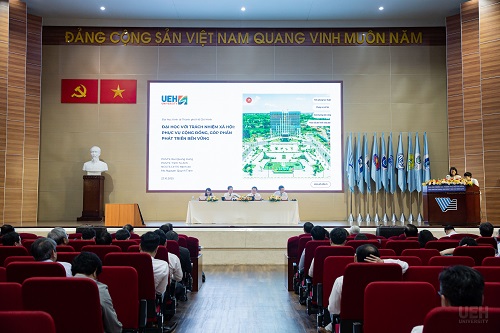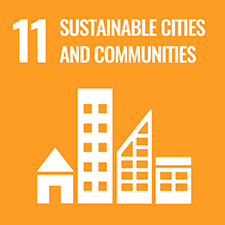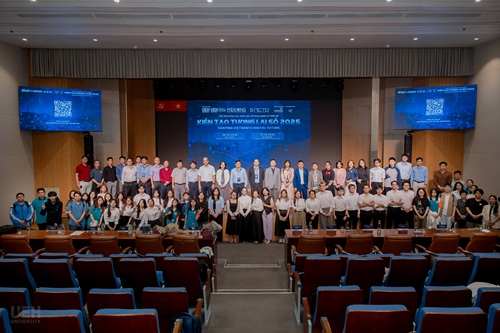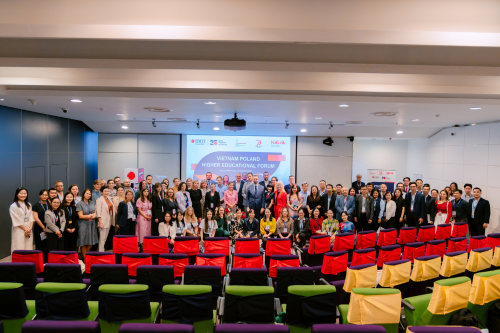
Employment Policy For Ho Chi Minh City in Post-social distancing Period
19 Sep, 2021
Human resource, one important issue, needs to be prioritized to be solved, especially in the current post-social distancing context. It can not be denied that this severe labor shortage affects all economical aspects. The authors have provided actual figures describing labor supply and demand issues as well as forecast the current employment situation, thereby, proposing short-term and long-term employment policies for Ho Chi Minh City in the near future.

Labor and employment context after social-distancing
After 4-month social distancing implementation, with timely regulations from Resolution 128/NQ-CP, Vietnamese economical activities are gradually returning. However, in terms of labor and employment, the impacts and risks from the pandemic are not small. According to data from General Statistics Office, this Covid-19 pandemic has negatively affected 59% of the population aged 15-and-over in Southeast region and 45% in Mekong Delta. Also in these two regions, the decrease in the number of employed people in 3rd quarter of 2021 compared to 2nd quarter was 14.7% and 8.7%, respectively whereas workers’ average income decreased by 30% and 14%, respectively, in the same period.
Besides, the pandemic can create a crisis loop with the formula: COVID-19 🡪 aggregate demand decrease/ production capacity reduction, supply chain disruption 🡪 job loss, income 🡪 decrease in aggregate demand 🡪 production stagnation 🡪 job loss, income 🡪 a decrease in aggregate demand and so on.
In this context, the source of labor is a very important issue. Ho Chi Minh City (HCMC) is facing a labor shortage as 1.3 million people have returned to their hometown and 2.5 million workers have to stop working. This situation requires appropriate and timely decisions from managers to attract the workforce back to the southern economic locomotive to maintain and develop production.
From an economic point of view, the above issue should be considered in accordance with supply and demand. Labor supply and demand are determined by each individual and the employer. In a normal state, the market will self-equilibrate labor supply and demand. In this situation of interrupted labor flow, unstable labor demand from the manufacturing sector as well as inconsistent socio-economic management policies due to the dependence on time and location of COVID-19 outbreak, Vietnamese State needs to intervene for a relative equilibrium achievement in the labor market.
Labor demand-side issues
In accordance with report by Vietnam Chamber of Commerce and Industry (VCCI), enterprises are facing rising production costs, in which labor-related costs is an important source. The increase in production costs comes from an increase in: (i) import prices and transportation costs; (ii) labor use cost (social benefits, paid leave, ‘3-on-the-spot’ working plan application and so on); (iii) occupational safety and health costs (bacteria elimination, means of epidemic prevention, social distancing, testing and so on).
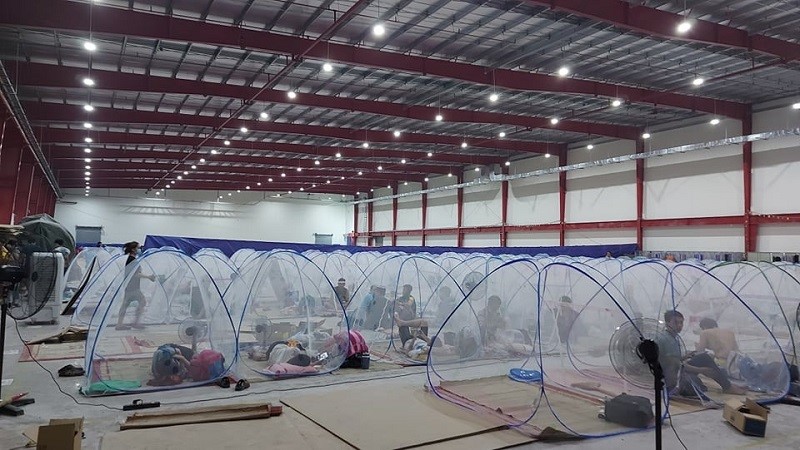
‘3-on-the-spot’ working model in places of businesses (Image source: Lao Dong Newspaper)=
Besides the cost problem, enterprises also face difficulties in technological innovation; ensuring export markets; signing a new contract and completing the signed contract; ensuring competition and maintaining production and business (production and business). In terms of labor, difficulties in recruiting and retaining workers are also mentioned by many enterprises, especially in service industry.
Some safety measures have been implemented by enterprises in the workplace, but the overall implementation rate is being low. This measure groups include: (i) Being recommended by Ministry of Health (approximately 54% of enterprises execute); (ii) Enhanced safety measures at enterprises (approximately 45% of enterprises implement); (iii) Implementing new working methods (less than 50% of enterprises apply) and (iv) Supporting staff in testing and vaccination (28% of enterprises participate).
Diverse government policies support businesses in this epidemic context; however, the access rate is being low and the policy effectiveness is not high. Three main policy groups comprise: (i) Tax support (CIT reduction, VAT, PIT, land rent and so on); (ii) Capital and credit support (restructuring of debt repayment term; exemption and reduction of interest and fees; keeping debt groups unchanged and so on) and (iii) Social security support (reducing insurance contributions towards accident insurance, retirement funds, loans to businesses for wage payment and so on). The access rate of enterprises in each policy group accounts approximately 25-35% and only 10% of them rate high policy effectiveness.
Issues regarding Labor supply
During the period from 4th quarter of 2020 to 3rd quarter of 2021, the third and fourth epidemics continuously pulled the total labor force down from 50.9 to 47.2 million people. Of the estimated 1.3 million workers who have left Ho Chi Minh City, it is forecasted that 377,000 people will return in the fourth quarter of 2021; 520,000 people returned after Tet Lunar New Year; 140,000 people will not come back and 230,000 people have no specific plan.
In accordance with the survey data from the group of workers who have left Ho Chi Minh City or Southeast region, factors that play a decisive role regarding workers’ returning to the workplace include: working conditions and income; medical conditions; living and living conditions; children' learning conditions and community habits. Surveyed workers are also worried about a variety of difficulties when returning to Ho Chi Minh City related to regulations on social distancing is unstable; travel and meeting epidemic prevention regulations; accommodation and daily life activities; employment and children' schooling.
In terms of the worker group remaining in Ho Chi Minh City or Southeast region, a significant proportion has quit or switched to other intermittent work. The rate of complete leave is 21.6% in the group with full-time work; 43.5% in the group with part-time jobs; 70.3% in the self-employed group and 45.7% in self-employed group. On the other hand, a large proportion has switched to intermittent work, with values of 21.6%, 30.4%, 16.2% and 25.7% respectively for the four groups mentioned above.
Regarding workers’ attitudes and opinions towards returning to the city, the proportions that favor the views of “staying in HCMC and trying to find a suitable job” and “coming back to the city for work and livelihood” in the worker group who does not leave HCM City do not show much difference (45.5% and 40.6%) whereas 56.6% of respondents in this group will give advice to their relatives in the direction of staying in their locality. For the group that has returned to their hometown, the percentage of workers who are advised that their relatives stay in the locality is not much higher than that of those that advise their relatives to go to other large cities (39.6% compared to 34.5%) while they themselves support the option of returning to the city (63.8%).
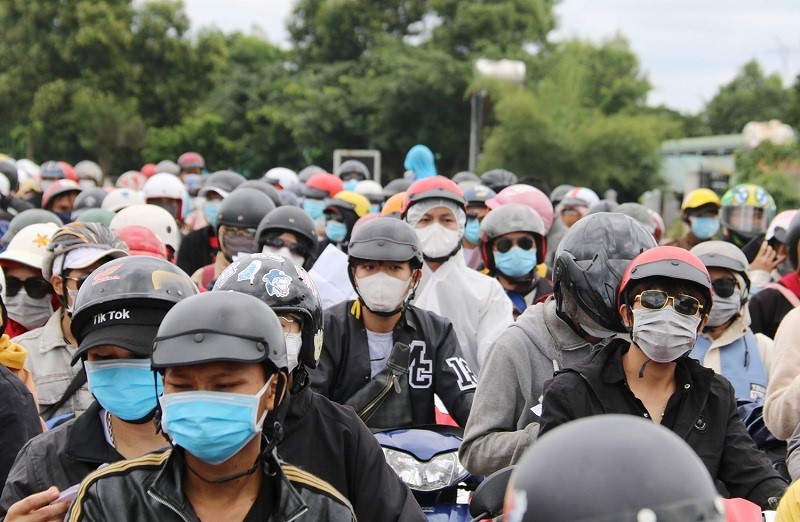
At the end of July, many people massively left localities with complicated development of Covid-19 epidemic to return to their hometowns. (Photo source: Tây Nguyên)
Forecasts of labor and employment situation
According to the forecast results, the labor force in Ho Chi Minh City will be narrowed, including migrant workers and local workers. The labor force participation rate of the young population aged 15-24 will decrease as unemployment increases. The unemployment rate of young workers will also be at risk of increasing. What is more, women's labor force participation and employment rates will also decrease besides the decline in employment and the slow recovery of occupational groups with a high concentration of female workers.
Other short-term forecasts are rather negative. The total job number, the number of working hours in the economy and the workers’ average wage will also decrease. Women, middle-aged workers and basic workers without technical expertise are the group of workers that will be long-term affected by the epidemic in the near future. Regarding the working position, salaried workers will decrease, self-employed workers will increase. This increases the vulnerable group of workers and puts pressure on social welfare in the future. Regarding labor contracts, the number of employees signed with labor contracts will decrease, which means that the number of employees who cannot pay social insurance and health insurance may increase.
Nevertheless, the ability to recover jobs in different sectors of the economy is different, some industries will recover faster and sooner than others. Industries with an increase in the employment rate include processing and manufacturing; information and communication; technological development; education and health services. Industries with a decrease in the labor rate can be mentioned as wholesale, retail, purchase, sale and repair of motorcycles and cars; warehouse transportation; accommodation and food services. Industries listed as mining; water and electricity supply; finance, banking and insurance; real estate business and other business services; state agencies; arts, entertainment and other family service activities are forecast to change little in the labor rate. These fluctuations will be temporary and the labor structure will continue to change when the economy enters the full recovery phase.
Proposing labor and employment policies for Ho Chi Minh City
* Direct job creation program from public projects
Direct job creation programs create additional jobs in projects that are of a community or socially beneficial nature. These projects are often temporary and non-market in nature. Direct job creation programs can also be large labor-intensive infrastructure projects. Workers participating in these programs are often long-term unemployed or those in the informal sector who have lost their jobs due to the Covid-19 pandemic.
Direct job creation or public job creation programs have three benefits: (1) Job creation for workers, especially disadvantaged groups; (2) Play the role of social protection, generating instant income; and (3) Public benefits/infrastructure work creation. As the labor market recovers, the direct job creation program will shrink.
Programs to create public jobs to cope with unemployment and support jobs for vulnerable people are quite popular in countries around the world. Size, employment, duration, coverage, salary and budget depend on local realities.
* Attracting employees back to work
Two policy groups as tools that attract workers to return to work are: (1) using economic incentives, affecting individuals’ economic motivation; and (2) using behavioral economic tools, affecting the economic motivation of individuals into workers’ mentality. Behavioral economics tools have been used in many parts of the world, especially in OECD countries. Many studies show the same results, behavioral economic tools have lower costs than economic incentives.
The main policy beneficiaries in this group are migrant workers who have returned to their hometowns and choose to work in the formal economic sector. Policies to attract laborers to return to work are in the group of policies in the short and medium terms.
Economic incentive policies include two groups:
Money: advance salary, labor contract
Benefits: accommodation, vaccines, testing, transportation, skill training suitable for new jobs.
Our research team proposes that state management agencies should develop welfare packages to attract workers back to work, including 3 main components: Job introduction + Accommodation support + Covid 19 vaccination.
Behavioral science measures (psychology):
Information/Propaganda: migrant/informal workers rarely follow official communication channels. Proposing the information dissemination regarding the working environment through social networks and celebrities. Building and strengthening trust. State management agencies provide policies and related information in a consistent and clear manner.
Social influence (information spread in groups, communities): The employee's decision to work is mostly influenced by the decision of the person in the same identification group (compatriot group, religious group, and so on). Promoting communication within the group and influencing the team leader can be effective.
Social norms: For example, how to motivate employees to return to work sooner, how to overcome the mentality of returning to work after Tet Lunar New Year (40% of survey respondents confirm that they only return to work after Lunar New Year. Only 28.7% are ready to return to work in 4th Quarter. See figure 2). Employee decisions are influenced by social norms. Changing the norm is difficult and takes time. State management agencies grasp this issue to have flexible policies.
It is possible to organize a task force to detail the use of behavioral tools. During implementation, the task force evaluates the effectiveness of the policy, assesses actual feedback and adjusts the policy as necessary. The specialized group may include labor managers, researchers specializing in behavioral economics and labor economics.
* Policies for group of labor demands (short-term policy)
This important group of labor policies solves labor and employment issues caused by Covid-19 pandemic. World Bank's summary shows that enterprise-focused labor market policies play a key role in labor and employment policies during Covid-19 pandemic in 55 countries.
Labor market policies mainly focus on supporting enterprises' liquidity and increasing flexibility in labor regulations. Policies to increase corporate liquidity/cash flow and flexibility in labor regulation are the most widely used labor market policies.
The research team proposes that among the policies to improve the liquidity of enterprises, state management agencies should consider tax support policies for businesses, like: corporate tax payment delay, VAT deduction extension, additional tax deduction, time limit extension for tax obligation settlement. Credit guarantee support, loan payment (lowering loan interest rates, debt restructuring) may be considered, postponing/reducing social insurance contributions for employees as well as supporting electricity, water and rent.
The liquidity support policy for enterprises should focus on the group of micro, small and medium enterprises, which is the majority of enterprises and employs many workers.
* Labor market development policy group (long-term policy)
As mentioned in the first part, one of the most difficult problems of the labor market is the connection between labor supply and demand, when information on labor supply and demand is unclear and uncertain. Connection problems will be even more difficult in Covid19 pandemic context. That Covid-19 pandemic disrupted business operations and mobility; concurrently, perceptions and attitudes leads to labor supply and demand behavior.
Our research team proposes that in the long term, state management agencies should invest in building a technology platform to connect jobs for the public sector.

A typical example of this is Australian Government's online job-matching site https://jobactive.gov.au/. The technology platform that connects public sector jobs makes it easier and more effective to promote the policy of direct job creation in Section 2.1.
Vietnamese State management agencies can also consider policies to support the development of job-connecting technology platforms for low-skilled workers. Currently, job matching apps in Vietnam (Vietnamworks.com, careerbuilder.vn, mywork.com.vn, 1001 vieclam.com, vieclam.24h.com.vn etc.) require certain skills; therefore, bypassing the unskilled labor sector, which requires little skill. Job matching platforms can be extremely effective in Covid 19 context when workers are at home and are considering looking for a job in the city. The technology platform makes it possible for workers to find work remotely: once they have determined the job, they can plan to move and live more easily.
This platform is based on a platform economic model, using digital technology to help connect the need to share idle human resources and the need to use those resources accurately, efficiently and quickly with and low cost.
Job matching platforms also help build a database on the labor market so that policymakers can have more accurate information on labor supply and demand in each locality.
Author group: Dr. Phạm Khánh Nam, Dr. Trần Mỹ Minh Châu, Dr. Hồ Quốc Thông, Dr. Nguyễn Quang, Dr. Trương Đăng Thụy (Economy Faculty – UEH School of Economy, Laws and State Management).
This paper is in Series Spreading researches and applied knowledge from UEH, we would like to invite distinguished readers Newsletter ECONOMY NUMBER #24 “Online security risk in digital banking activity – The case of Việt Nam”.
News, photos: Author group, UEH Department of Marketing – Communication.



